
本篇文章主要基于mlir的公开talk,深入理解一下mlir中的operation,attributes以及properties机制的底层实现。本文先着重解读operation的底层实现机制。
MLIR Operation Intro
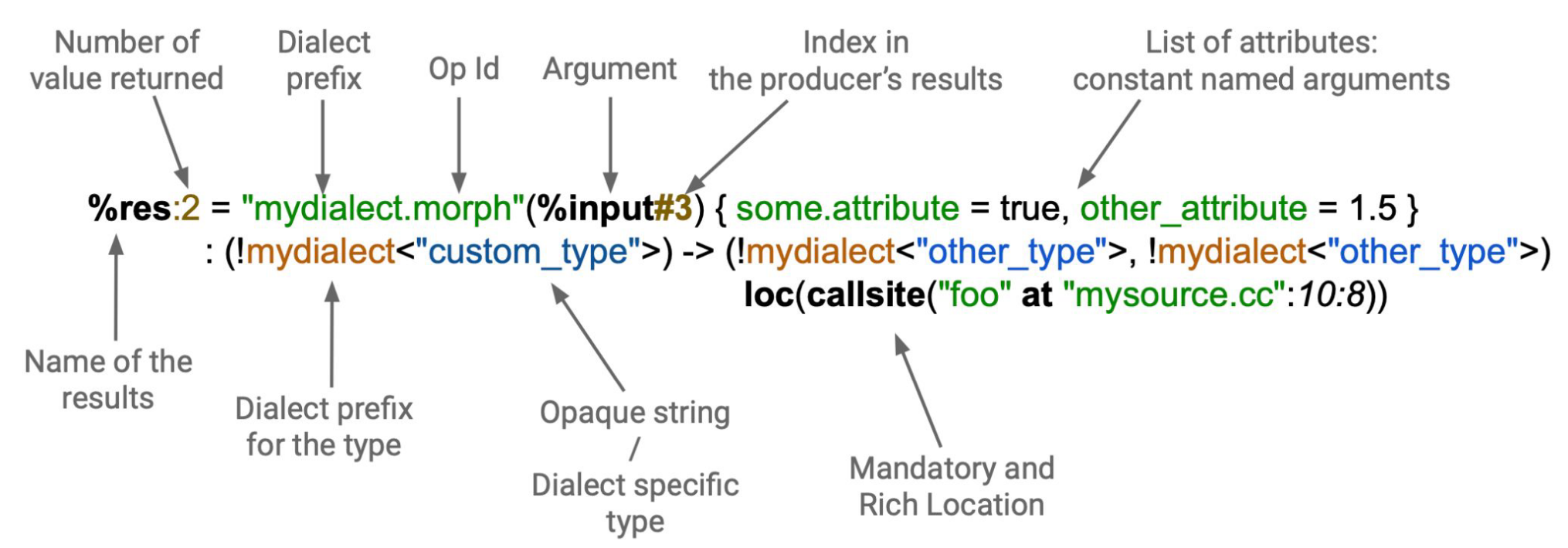
上图来源mlir tutorial。mlir operation是MLIR系统中最基本的可执行单元,其涵盖多种不同的抽象层级的计算(按照硬件相关性分类,可以分为硬件相关和硬件无关。抽象层级上,也有诸如vector operation和memref operation)。上图已经涵盖了operation op的每个细节,详情可参考mlir operation docs。
具体的使用细节,可以参考HarmonyHu MLIR技术细节整理。
mlir::Operation是通用定义,包含通用的接口和属性;MulOp、TransposeOp、ConstantOp等等是特定定义,包含特定的属性。前者可以通过llvm::dyn_cast(动态)或llvm::cast(静态)转换成后者;后者通过getOperation()转换成前者。
1 | void processConstantOp(mlir::Operation *operation) { |
特定Op可以直接访问属性;mlir::Operation无法直接访问特定Op的属性,但可以类似如下间接访问,如下:
1 | // getAttrOfType |
operation的具体使用方面,提供了如下接口:
1 | OperationName getName() { return name; } |
MLIR Operation Internal
前一章节主要介绍mlir operation以及其使用细节,而这一章则深入挖掘operation的底层实现存储。本章主要参考mlir properties talk。
首先我们先来看一下mlir的官方doc中,对于operation的底层细节的一些描述:
An Operation defines zero or more SSA
Valuethat we refer to as the Operation results. This array of Value is actually stored in memory before the Operation itself in reverse order. That is for an Operation with 3 results we allocate the following memory layout:[Result2, Result1, Result0, Operation] ^ this is where
Operation*pointer points to.A consequence of this is that this class must be heap allocated, which is handled by the various
createmethods. Each result contains:
- one pointer to the first use (see
OpOperand)- the type of the SSA Value this result defines.
- the index for this result in the array. The results are defined as subclass of
ValueImpl, and more precisely as the only two subclasses ofOpResultImpl:InlineOpResultandOutOfLineOpResult. The former is used for the first 5 results and the latter for the subsequent ones. They differ in how they store their index: the first 5 results only need 3 bits and thus are packed with the Type pointer, while the subsequent one have an extraunsignedvalue and thus need more space.An Operation also has zero or more operands: these are uses of SSA Value, which can be the results of other operations or Block arguments. Each of these uses is an instance of
OpOperand. This optional array is initially tail allocated with the operation class itself, but can be dynamically moved out-of-line in a dynamic allocation as needed.An Operation may contain optionally one or multiple Regions, stored in a tail allocated array. Each
Regionis a list of Blocks. EachBlockis itself a list of Operations. This structure is effectively forming a tree.Some operations like branches also refer to other Block, in which case they would have an array of
BlockOperand.An Operation may contain optionally a “Properties” object: this is a pre-defined C++ object with a fixed size. This object is owned by the operation and deleted with the operation. It can be converted to an Attribute on demand, or loaded from an Attribute.
Finally an Operation also contain an optional
DictionaryAttr, a Location, and a pointer to its parent Block (if any).
总结一下,mlir operation的底层细节中,比较有趣的点:
- 操作的结果是以逆序存储在operation之前,并且前5个result和之后可能的result存储大小不一样,这个机制类似llvm的llvm::SmallVector实现。
- operand是尾部存储的方式存储在operation之后,旨在提供可扩展和可修改性(operand本质是对SSA value的引用,在mlir中经常会有修改引用的情况,比如replaceAllUsesWith()),同时也支持动态存储在别处。
- 一个operation会有多个region,也是尾部存储方式存储。
针对这些有趣的点,我们后续主要挖掘operation类的具体实现,以及operation前存储和tailing存储等技术细节。
Operation类的定义

如图所示是/include/mlir/ir/operation.h文件,截取的是operation类的定义,继承自ilist_node_with_parent和TrailingObjects。
ilist_node_with_parent
参考llvm member list文档,其定义如下:

是一个双向链表,允许operation获取其prev节点和next节点,分别有如下api调用:

这个链表属于侵入式链表,和朴素的std::list有区别,具体参见Boost侵入式链表文档。这一块比较复杂,后续再学。
Trailing Objects
Trailing Objects的原理十分简单,如下是c++中的解释:
是一个在 C++ 中的术语,指的是一个对象,它紧跟在一个类的末尾,并且其大小是动态的或不固定的。通常,尾部对象用于在类内部存储一些额外的数据,这些数据的大小在编译时是不确定的,可能根据运行时的条件或对象的使用来决定。
在llvm/include/support/TrailingObjects.h头文件中,有对于这个类的详细定义。注释中给出一个如何定义trailing object类的例子。
类的定义
1 | // 定义VarLenghObj,该对象有固定的int和可变的double数组 |
注意这里有一个关键点,double是尾元素,因此其长度是可变的,所以没有numTrailingObjects方法实现。
内存分配
1 | size_t Size = VarLengthObj::totalSizeToAlloc<int, double>(NumInts, NumDoubles); |
访问数据
1 | int *Ints = Obj->getTrailingObjects<int>(); // 访问 int 数组 |
Operation类的实现
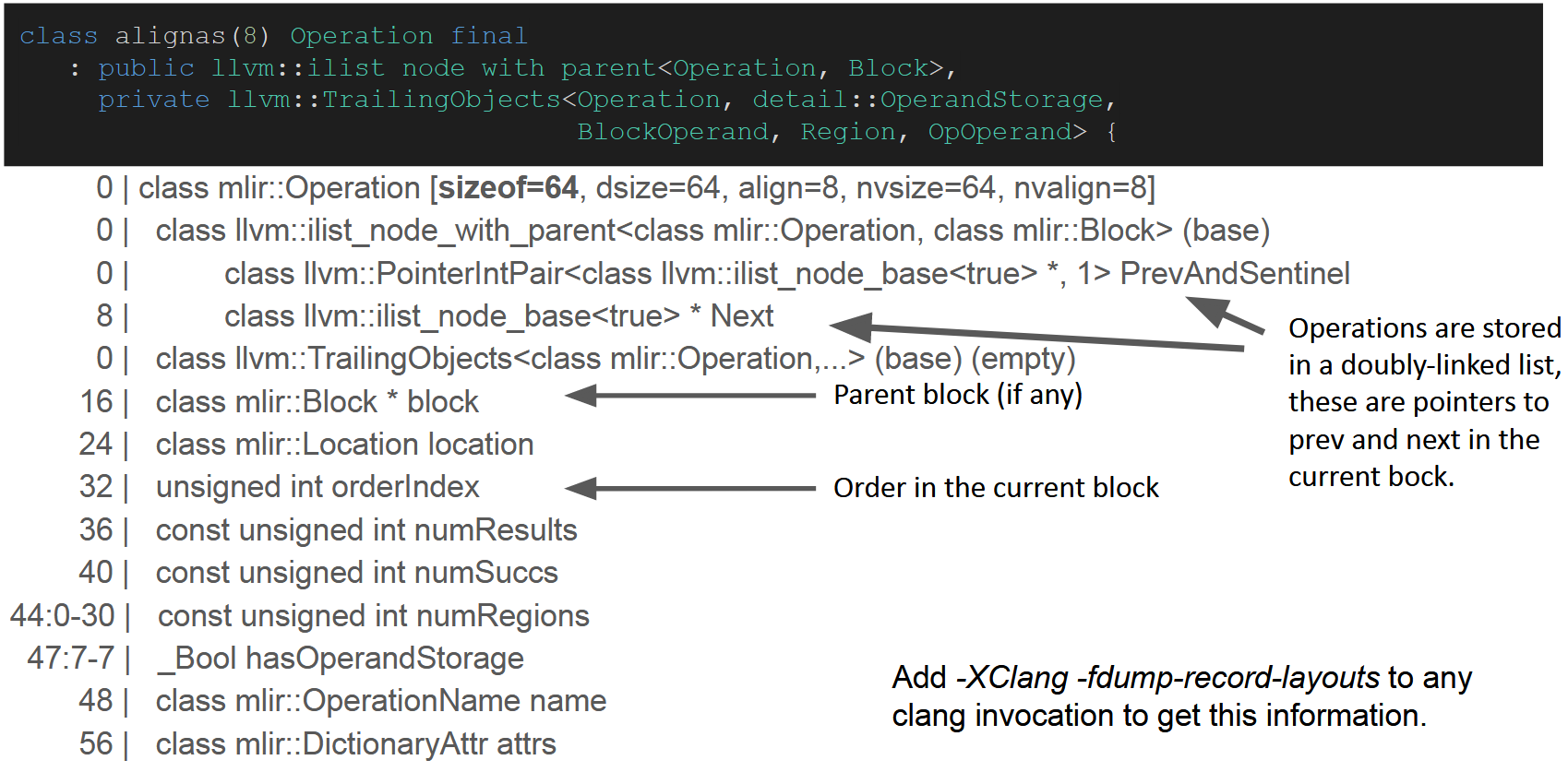
这张图解释了operation的实际存储,具体如下:
- 前16bytes是前序节点和后继节点,注意前序节点是ilist_node_base类型加一个int,用来表示哨兵。
- 后续是block指针等信息,同时还有region,results等个数。
上述的trailing objects中,只有OpOperand是编译时不确定可变的,其他均可通过operation这64bytes信息中的num值来推导实际存储位置,如下图所示:
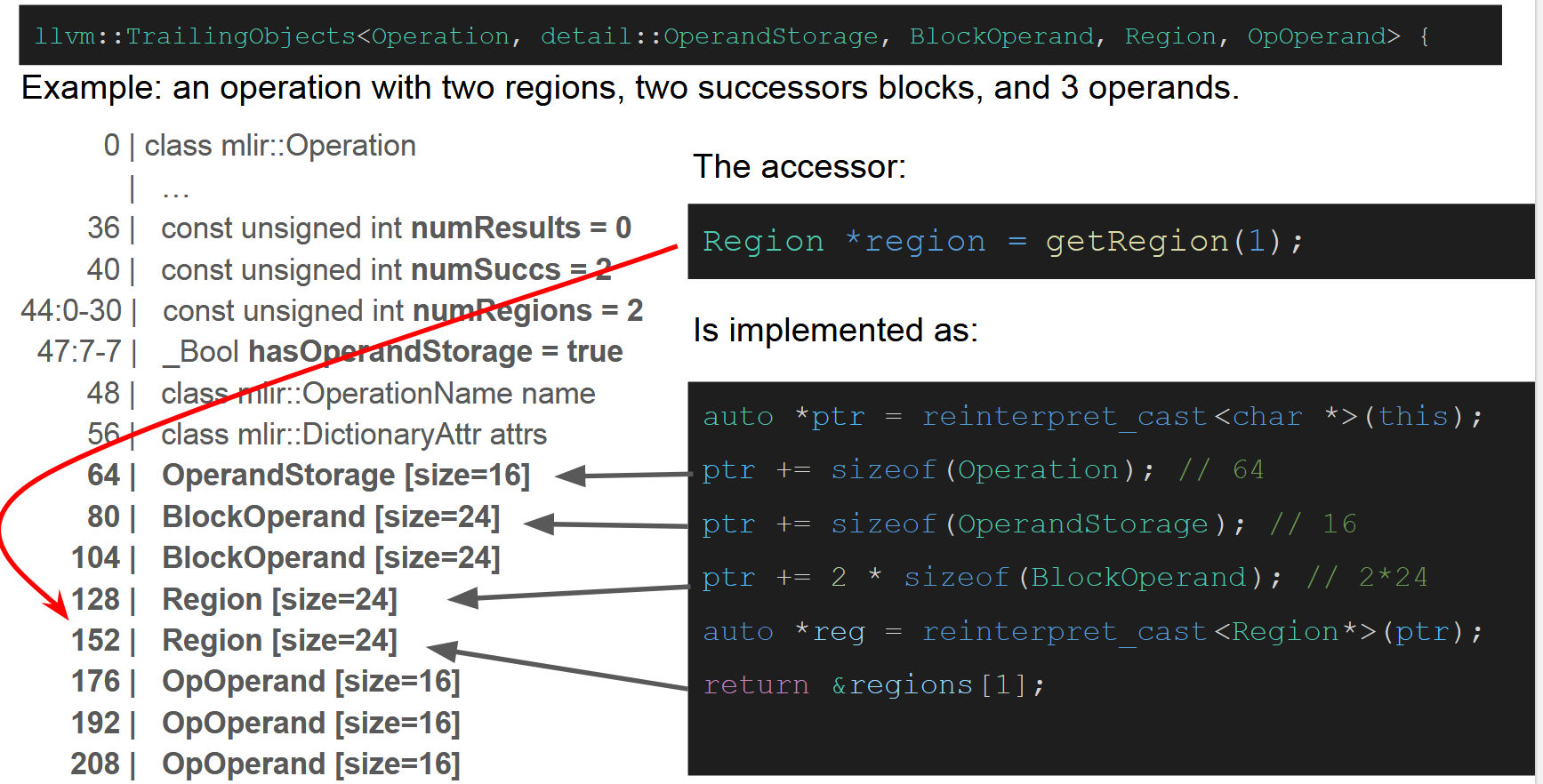
该图展示了operation的getRegion()方法的底层实现原理。而唯一特殊的点就是OpOperand,是tail-allocated或是和operation存储分离的。该OpOperand的定位通过64bytes中的OperandStorage来辅助:
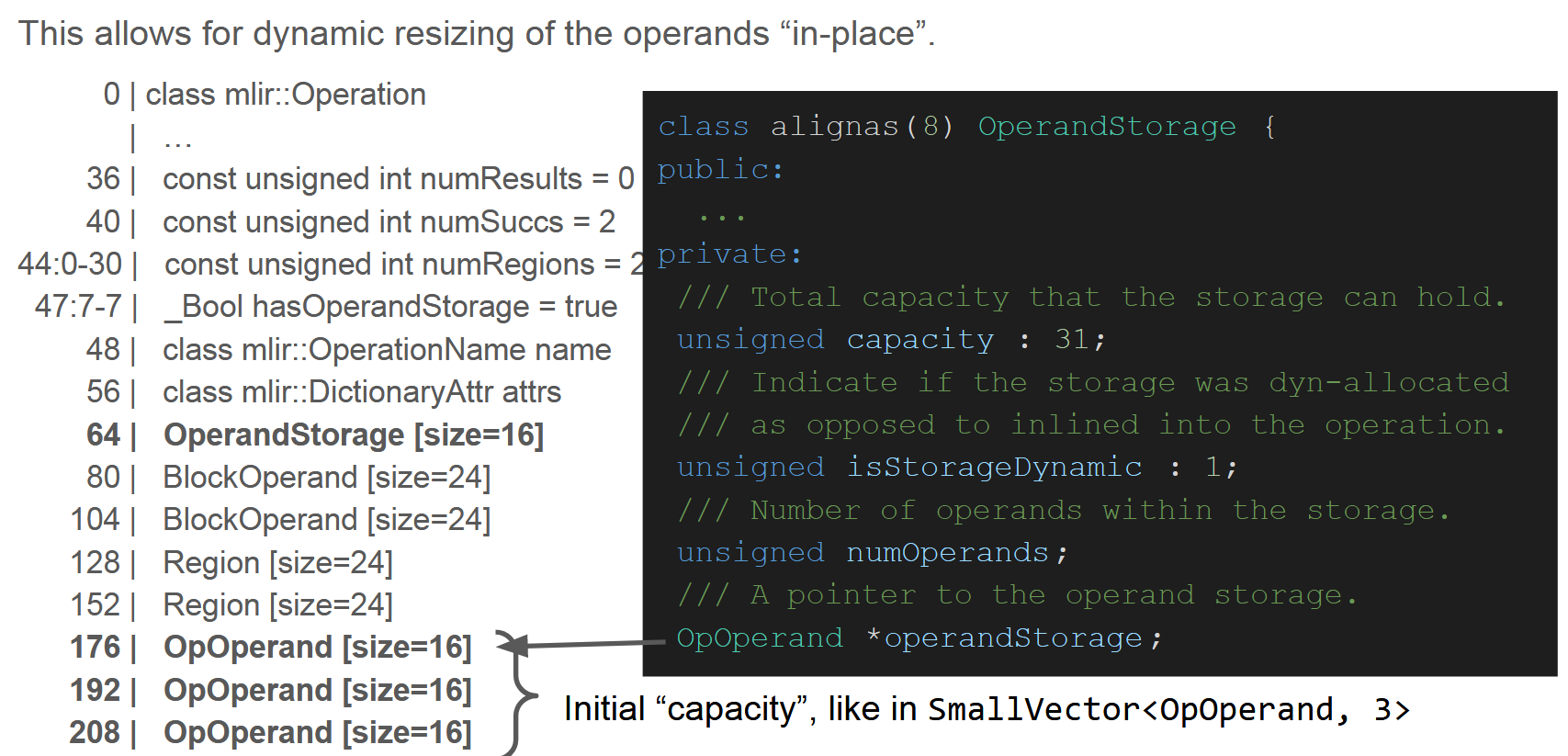
该OperandStorage中存储OpOperand指针,以及总共有多少operands。添加operands,这种模式也十分容易动态扩展。
解读完OpOperand,region等信息后,operation还剩一个关键信息:result。
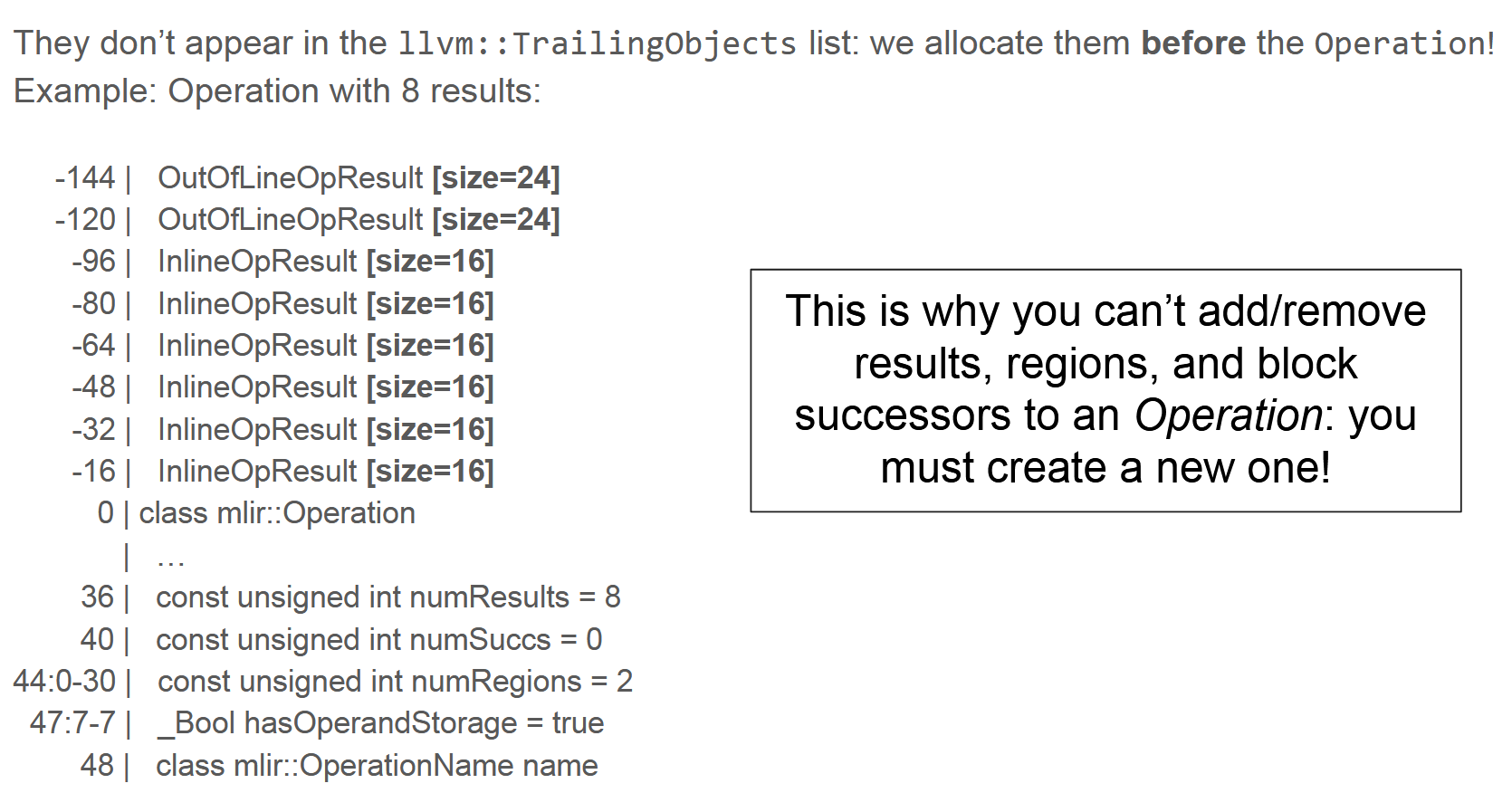
result的特殊性是其存储在operation存储体的前面,没有放在trailing objects中。其设计思路参考SmallVector设计,分为OutOfLineOpResult和InlineOpResult,对于少量result情况(<=6)可以有效压缩空间。其主要思路是用3bits表示有限的index索引,而超过3bits范围,则使用int表示索引范围,使得前六个result占用16bytes,其余为24个bytes。
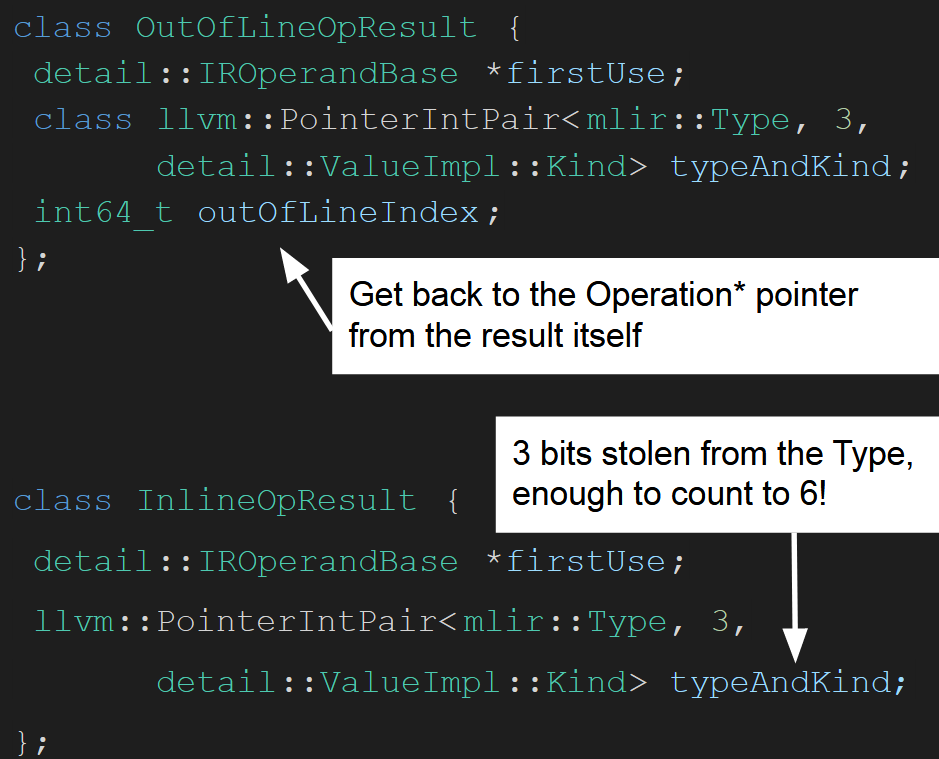
从operation中获取指定的result,其实现如下,逻辑是比较清晰简单的:
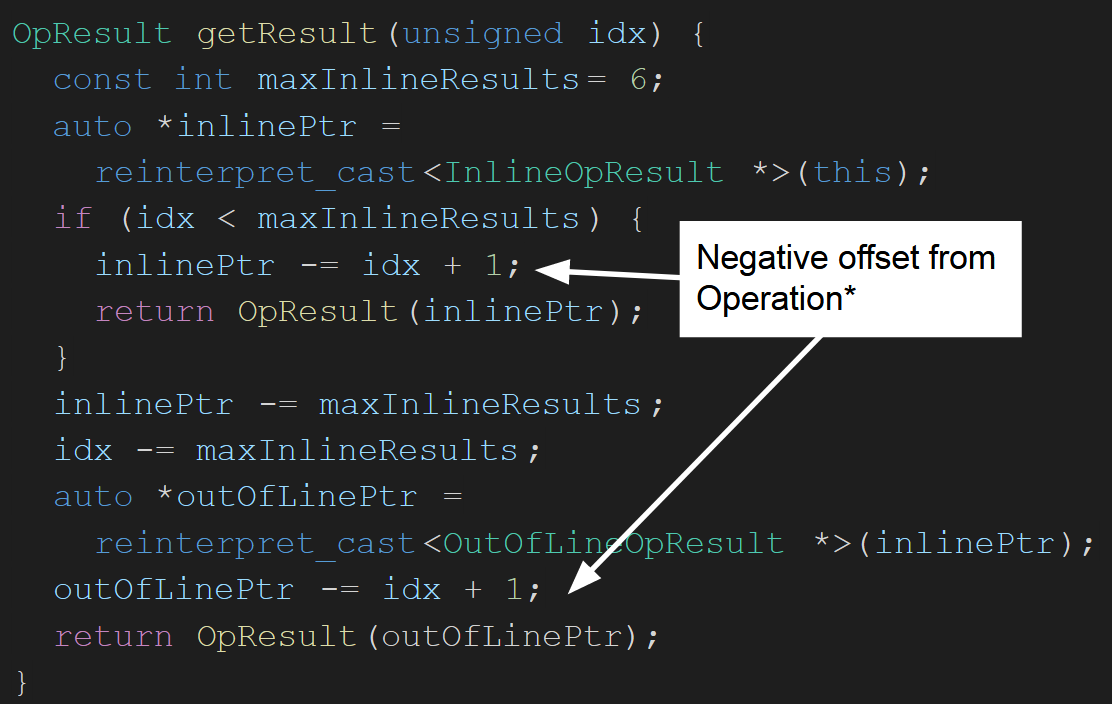
同时也支持从result获取operation这样的操作。逻辑和上图基本一致。
如下图是一张很好的operation结构总结图:

Debug实战
mlir的debug tips参考[debug博客](MLIR debug tips | Leon’s Blog)。首先打断点打在如图所示:
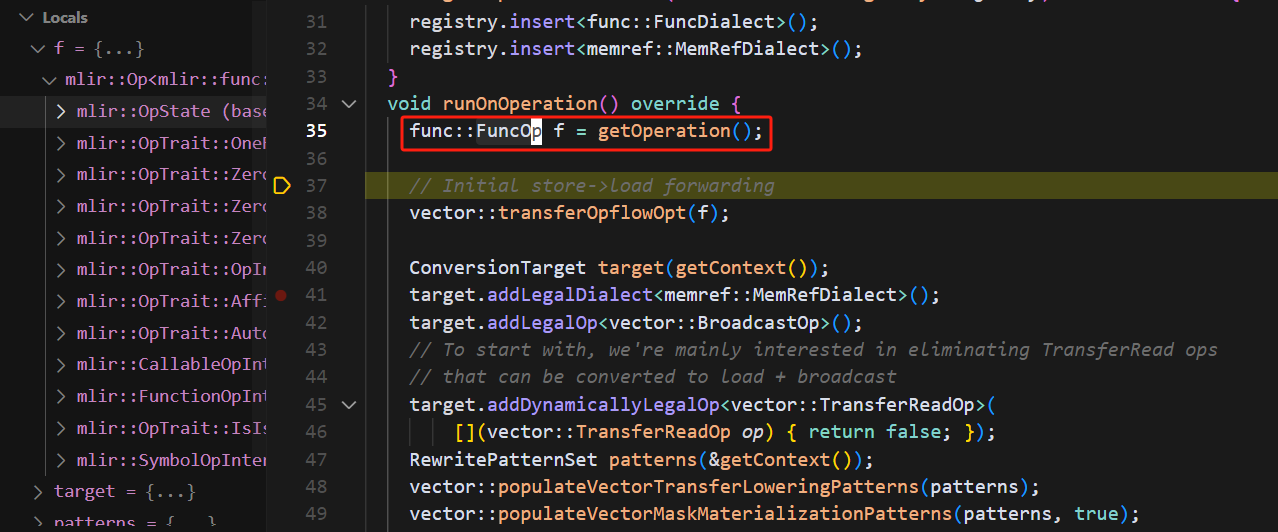
我们重点关注func::FuncOp的实现。

可以看到,OpState是指向operation实体的指针,其余均是OpTrait萃取或是interface接口,不属于本章节内容。

可以看到,OpState是符合前几章讲解的底层实现。
至此,解读完mlir的operation的底层实现,下一章节会重点解读mlir的attributes机制的底层实现。